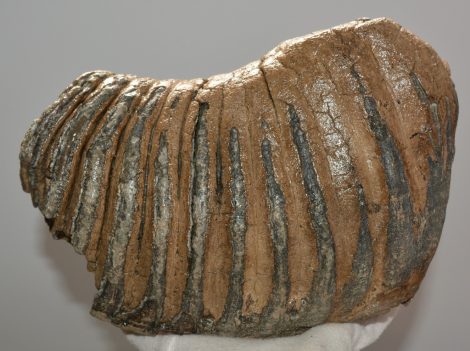- New arrivals
- Products in stock
- Mammuthus fossils [511]
- Megaloceros deer fossils [19]
- Bison Bos fossil [23]
- Rhinoceros fossil [33]
- Echinoderms sea urchin fossil [27]
- Plant wood fossils [38]
- Fish and shark fossils [48]
- Ammonites cephalopods [28]
- Mammalian vertebrates fossils [69]
- Dinosaurus fossil [44]
- Shells fossils [12]
- Gastropods fossils [30]
- Coral fossils [5]
- Trilobites & Crabs fossils [27]
- Minerals [26]
- Insect fossils [19]
- Other Fossils [12]
- Books, literature [10]
Mammuthus cf. meridionalis partial tooth (4519 grams)
Partial tooth of Mammuthus cf. meridionalis (southern mammoth). The mammoth fossil was unearthed during gravel mining in Pest County, Hungary. The tooth measures approximately: length 245 mm, height 163 mm, width 96 mm. Weight approximately: 4519 grams + packaging. The interesting thing about the tooth is that its chewing surface is barely worn. The surface of the tooth is preserved with a substance called Polyvinyl Butyral 30 dissolved in ethanol.
"(Archidiscodon) Mammuthus meridionalis: Body size: 3.5-4.2 m. Weight: approx. 7000 - 10000 Kg. Geological period: Lower Pleistocene, 2,500,000 - 550,000 years ago Geographical distribution: Europe (Western and Southern Europe)
This species is also called the "elephant of the south". It appears in the mammalian fauna of Europe with the Pleistocene, so it may even be a symbol of the beginning of the Quaternary. It is the earliest representative of true elephants. Its back was almost straight, only slightly curved, while that of the African elephant living today slopes steeply from the front shoulder girdle. The tusks of the huge males bend slightly outwards at their base, then horizontally and at the same time in a lute shape towards the middle. The tusks of the females were much smaller, did not bend upwards and did not they twisted inward. Archidiscodon meridionalis was a savannah inhabitant, but it also lived in sparse scrubland and forests; it did not inhabit the grassy steppes that could be called steppes.








